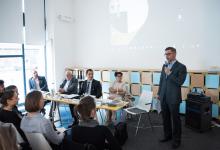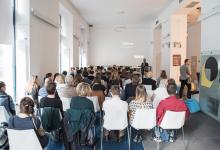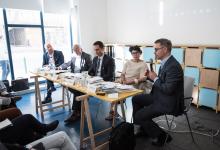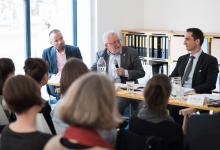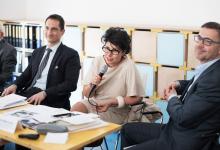THE EXHIBITION OF THE LÁSZLÓ MOHOLY-NAGY DESIGN GRANT PROGRAM 2016 WAS OPENED AT THE CONTEMPORARY ARCHITECTURE CENTRE
31 March 2017, Budapest ... The exhibition displaying the grantees of the László Moholy-Nagy Design Grant Program 2016 was opened at the Contemporary Architecture Centre (KÉK) today. The opening ceremony of the exhibition, which can be visited until 30 April 2017, took place as part of the program jointly managed by the Hungarian Design Council and MOME+ (the incubation program of Moholy-Nagy University of Art and Design Budapest). The young grant holders made presentations about their works and the invited experts discussed various issues such as the incubation potential of the Grant Program and the conclusions of the examinations of the grant program at round table talks.
In his opening speech, dr. Viktor Łuszcz, President of the Hungarian Intellectual Property Office and the Hungarian Design Council said: „The László Moholy-Nagy Design Grant Program is regarded as a case that is based on cooperation and that supports incubation. Various aspects such as economic and creative opportunities arising from and as a result of project development and the development of professional skills and competencies are considered here.”
He also added: „we are continuously monitoring and responding to the demands and capacities of students and graduates in national design education. We dynamically adapt our programs to these needs to support students to start their career, to deepen professional skills, to realise their plans and to achieve professional independence.”
More than a hundred young Hungarian designers were offered support for professional development through the Moholy-Nagy Design Grant Program in the last thirty years. The program, which has been more and more attended by industrialists and manufacturers, and which has received an increasing amount of attention from economic decision-makers, offers real future opportunities to grant winners and their projects.
PROGRAM ADVISOR
MOHOLY EXTRA: The László Moholy-Nagy Design Grant Program 2016,
Contemporary Architecture Centre (KÉK), 1111 Budapest, Bartók Béla str. 10-12.
The exhibition of the grantees is open to visitors at KÉK until 30 April 2017.
Opening hours: 9:00-18:00 every day.
The grant holders of the László Moholy-Nagy Design Grant Program 2016
Anita Boldog
Concrete gift collection for business partners – representative design objects for construction companies
Some of the most unrespected design objects are gifts with a company logo. This attitude has been challenged by Anita Boldog, who has had an own brand for many years and whose company deals with concrete. Primarily the representatives of companies in the construction industry are targeted with their gifts. The base material of their objects is good-quality concrete and they are mainly inspired by the brutalist architecture, which was quite popular in the 50s and 60s and which is experiencing a second bloom these days. The pendrives, business card and ball-point pen holders are made of geometric and architectonic elements and they resemble the sketches of miniature buildings.
Emese Fabricius-Nagy
IORA – modular system – bag collection
www.facebook.com/mesmanufactory
IORA was inspired by the inner structure, the space-saving geometric shaping of pomegranate. Starting from this natural image, Emese Fabricius-Nagy designed this easily and rapidly producible, but still customisable bag collection by experimenting with various base materials and fitting techniques. Her design, which mostly follows the structure of the classical football of the 70s, is hexagon flat surfaces combined with pentagons. An environmentally friendly plastic was used for the materials of the elements; fittings were managed with flexible switches and modules were simply snapped together. Beside the reasonably priced version, an upmarket product with premium quality materials will also be designed in the future.
Demeter Fogarasi
Modern handcrafted furniture
Demeter Fogarasi regards furniture as “personal objects that fill in and animate space”. Having designed the furniture Pinsofa 1, which resembles a cushion full of pins, the designer started to develop a furniture family that would rely on handicraft traditions but apply modern technologies at the same time. The furniture elements follow the same concept but they are very different, regarding their shapes. The core of this method is that furniture models are produced out of everyday objects, by re-scaling them into real-life furniture. The designer experimented with various development paths and finally, he chose to design chairs made of grout crosses that were used for tiling. The end product was a holstered chair and a stool which were manufactured by a 20 time magnification, through various technical experiments, adopting the same principles as in case of Pinsofa 1. In the course of production, unusual objects and situations emerge that break with the usual context and the various pieces of furniture appear as independent characters.
Mónika Kovács
Metal textile project
www.cargocollective.com/monikovacs, www.komonka.hu
Mónika Kovács is looking for new potential interfaces between contemporary architecture and textile: she is experimenting with traditional handmade techniques in her collection, but using metal fibres at the same time. The tissue structure is produced by installing brass, copper and steel fibres and the surface is shaped by fracturing the threads. New sample layers, various organic patterns are produced as a result of the corrosion of metals exposed to the changing weather in the built environment; and symbiotic constructs emerge in the metal and textile tissue through the combination of different materials. The combination of the mate and grey coloured cotton and the metal fibres with different thickness and reflective capacities result in rich colour effects. An ideal place for the products is regarded a thermal bath by the designer since the vapour would form organic patterns on the special textile tissue and thus, it would serve not only as an object of decoration but it would harmonise with other elements of interior design through actively shaping and separating space and covering walls.
Ninetta Németh
Zero waste raincoat – a raincoat collection made by zero waste tailoring
‘Zero waste’ refers to a new technology in garment manufacturing, which ideally reduces fitting waste to zero. This was used as a basic principle for designing the raincoat collection by Ninetta Németh. She aims to produce models that can be used every day, regardless of age and sex, as economically as possible. While a functional and practical item of clothes is produced, the real message is not in aesthetical appearance or usability but in realisation and in the course of production.
This raincoat, which is produced 100 % out of recycled materials, is naturally water-proof, comfortable and endurable as well. The designer made raincoats in three different sizes for males and females and all the items were produced from one single pattern.
Ágnes Sass-Hegedűs
Design porcelain lamps for Herend Porcelain Manufactory Ltd
One of the most important milestones of the Moholy-Nagy Grant Program was the special relationship with the Herend Porcelain Manufactory, allowing young designers to test their ideas by experimenting freely and enjoying professional assistance, but under real market conditions. Furnished with the experience from the long-standing cooperation with the manufactory, Ágnes Sass-Hegedűs started to design a new lamp made of Herend porcelain, which significantly differed from the classic-line vase lamps. The designer acquired inspiration from traditions and natural forms; she produced interior design elements out of linkable porcelain items to decorate inner space like jewels. The hanged lamp body with its modular built of repetitive forms resembles a collar of pearls and it primarily offers moodlighting. The centre piece is made of an aluminium axis of LEDs; almost all of the elements are available in the shops so there is no need to manufacture new pieces. The additional elements fit into all the porcelain parts, they can easily be replaced or improved and new, special compositions can be designed. Handicraft work, just like industrial innovation, plays a special role in the lamp composition and they reflect the combination of tradition and innovation that is so characteristic to Herend.
The László Moholy-Nagy Design Grant Program
The Grant Program, which dates back to almost 30 years, annually invites young, independent designers’ works. Winners receive a grant of gross 150,000 HUF per month, for a period of 6 months, at the end of which they display their works to the public at an exhibition and also make a written and oral presentation to the grant committee. Young designers and industrial artists with a professional degree who are less than 35 years old and who live and work in Hungary are eligible to apply for the grant.
The Grant Program, which was announced by the Hungarian Intellectual Property Office (on behalf of the Hungarian Design Council) in 2017 and financially managed by the Hungarian Designers’ Public Benefit Non-Profit Ltd., was co-financed by the Ministry of Human Capacities, the Hungarian Intellectual Property Office, Herend Porcelain Manufactory Ltd. and this year also by Nyír-Demonich Ltd. and Planet-Gép Ltd. The exciting tasks in the manufacturers’ cooperation offer special opportunities: beside Herend Porcelain Manufactory, three other companies, Maform Ltd., Multinetwork Ltd. and Mobilsofa Ltd. have announced an independent tender.
A MOME+
The Moholy-Nagy University of Art and Design Budapest (MOME) define itself as a leading actor of the Hungarian creative industries and innovation activities in the long run. One of the major elements of multi-level activities reinforcing this idea is the MOME+ experimental incubation project. MOME+ elaborates and launches programs that are built on the special conditions of the university and customised to the students’ and alumni’s demands and capacities to help them start or pursue their career and to become independent professional designers. MOME+ aims to explore and reinforce the joint areas between MOME gradual courses and its research, development and innovation activities, furthermore it creates channels to ensure social and market usability of the university’s achievements.
For more information: mft.org.hu ⎜ facebook.com/magyarformatervezesidij
More information for the media:
Natália Fábics (HIPO, from part of the Hungarian Design Council)
Arven PR & Communications
+36 30/924 42 24
arvenpr [169] gmail [961] com





